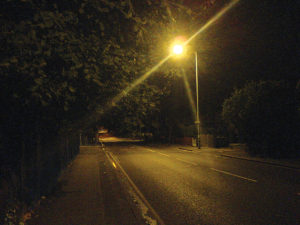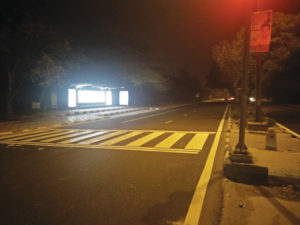AAP government is finally installing nearly 2 lakh CCTV camera mapping every corner of Delhi in its width and length. Will it be a game-changer for women’s safety?
Delhi has not forgotten Nirbhaya’s death, yet five years after the young paramedic’s gruesome rape and murder, the city’s crime statistics are sobering.
An infant was recently raped, reportedly by a relative, and a man caught on camera pleasuring himself while sitting next to a woman in a DTC bus. According to data given out by the police for 2016, women made a distress call to helplines in Delhi every 9 minutes on an average, filed a molestation complaint every two hours and reported rape every four hours.
The horror stories come from dark, deserted roads, far-flung areas and even central hotspots of the city on a regular basis.
The ignominious tag of “rape capital” seems to have stuck, and the number of cases of crime against women has only surged when one would have thought it would go down in the wake of promises made and actions taken by the state’s successive governments to boost security.
To be fair, fast-track courts were launched after the Nirbhaya gangrape, a fund was created and 24X7 helplines installed for rape victims. Stricter punishment for gender-related crimes was legislated. Safety apps proliferated, like the pepper spray, and women were schooled in self-defence. Even taxi and auto drivers were given classes on gender sensitisation.
But all that has come to naught. Now, the AAP government in the capital is pushing for CCTV cameras to deter criminals. Let’s see how that works out.
Five years after the horrific gangrape and murder of Nirbhaya on a dark and lonely road jolted the public, police and Delhi government, there still exist vulnerable stretches and deserted spots in the capital that send a shiver down many a woman’s spine.
The authorities in India’s capital at that time (December 2012) —probably pricked by their conscience or moved to action by the protesting public or shamed by international condemnation — had promised, among other things, constant surveillance of roads through CCTV cameras to beef up security for women.
The incident brought down the Congress government, and the Arvind Kejriwal-led AAP took over the reins of the capital, vowing to make it safe. CCTV cameras were installed, but at a few places on MLA funds, or by local bodies such as Resident Welfare Associations (RWAs). The Nirbhaya Fund was launched, remained under-utilised and was recently slashed by the central government.
Now the AAP says it’s ready with its first city-level project, and will set up 1.94 lakh CCTV cameras by October at markets and residential areas to watch the city.
The project, worth R272 crore, has been given to Bharat Electricals via a tender released by the Public Work Department (PWD). According to them, daytime coverage of the CCTVs will be 100m, and infrared technology will be able to cover 30-40m at night. Maintenance of the cameras will be PWD’s responsibility for first five years, after which they would be taken over by the RWAs, which are planning to set-up control centres to monitor live feed. Devices will be installed at locations chosen by MLAs in consultation with the RWAs and other stakeholders.

But in the intervening years since 2012, how has the city fared? Patriot did a recce of some spots in Delhi at night that make the skin crawl. See if the list gives you shivers too.
1) Vasant Kunj
Just ahead of Jawaharlal Nehru University’s new campus is the road that heads to Vasant Kunj, where the buildings end and the forest starts. It is nightmarish. Several crimes have taken place here, including rape and abduction.
Go a bit further and you reach the accident-prone Nelson Mandela Marg, considered one of the most unsafe roads in Delhi where journalist Soumya Vishwanathan was shot dead. The stretch has a jungle on one side – an ideal spot to commit a crime and flee. Some way ahead is Vasant Kunj Marg, which opens to a metro station, but is no less scary.
The few patrolling policemen claim security has been tightened in the wake of the incidents, and point to the nearby glitzy malls, police vehicles and night checkpoints to say that the risk has decreased.
2) Guru Ravidas Marg
According to the DCP office (south-east), the police get the maximum complaints of crime from Govindpuri and Jaitpur police stations. The station house officer at Govindpuri police station told The Patriot that the areas around the ridge forest of Tughlaqabad are vulnerable spots where it is easy to commit a crime and disappear into the darkness.
But unlike how it was made to appear, the Guru Ravidas Marg (from the metro station) in the over-habited and well-lit Govindpuri didn’t seem like a crime-prone stretch, except for the road ahead of Tara Apartment. It has Jamia Hamdard and Majeedia Hospital on one side and an unguarded and unlit park at the other.
3) Mehrauli-Badarpur Road

The road houses security authorities such as the Indo-Tibet Border Police and the Air Force Station, and even the police station of Pul Prahladpur. Turn from Guru Ravidas Marg towards Badarpur on the MB Road, and it’s time to lock all the doors and drive faster – there’s a forest on one side and a huge ground on the other with broken walls. Worse: poor lighting throughout the stretch. Unless one passes by regularly, it would be difficult to see the Kaya Maya Hospital, Tughlaqabad Fort, the Dr Karni Singh Shooting Range and Suraj Kund. Considering the vulnerability of the area, there’s a police van or two parked near the fort, but they are insufficient for the length of the road. Passers-by say they have spotted young boys with pistols around the fort.
4) Press Enclave Marg
“My relative was admitted at the Pushpawati Singhania Hospital in the recent winter and I used to stay there,” says Pooja, a resident of Devli, proceeding to narrate what happened there.
“Only one or two buses ply from Devli to the hospital. So, I generally get down at the Sheikh Sarai crossing and walk. It was the first time I was going to the hospital alone at night, and it wasn’t a pleasant experience. Though there is a police checkpoint at the beginning of the road, there’s absolute nothing beyond. While walking towards the hospital, I was bothered by slow moving cars. To be safe, I paused at the bus stop to take a bus for the remaining distance. A bus did come, but didn’t halt. In fact, a biker stopped and offered me a lift. I could not understand if he wanted to help me or take advantage of my loneliness and fear. I ignored him and he started following me. I politely refused again but he continued to trail me until I turned right towards the hospital – only to discover that a car was following me. I literally ran inside the hospital gate. It was the scariest night of my life,” she adds.
The nearby area of Saket is otherwise famous for malls. Sharing a border with Malviya Nagar, Sheikh Sarai and Chirag Delhi, it is overcrowded by colonies and many posh societies. Other than these, the district court and hospitals keep the street bustling. But no sane person would dare to walk on the road Pooja described, at night.
Despite the existence of a hospital, the road is not lit beyond 100 metres of the building, including a police post. The unguarded, dark Satpula Dam and the huge DDA Park nearby make the area spooky and dangerous.
5) Jahanpanah City Forest
The huge city forest, Jahanpanah, spread over 400 acres, contours a vast area of Greater Kailash-II, Tughlaqabad Extension, Batra Gate, Dhobi Ghat, Sheikh Sarai, Chirag Delhi, Masjid Moth DDA Flats and Balvantray Mehta Vidya Bhawan School. The walled forest-turned-park is crowded every morning and evening by residents from the nearby localities, who come there to work out amid the fresh air and greenery.
But it is not a safe place to hang out beyond those times, and never at night, says Joel D’Souza, a resident of Kalkaji.
Other visitors reveal that there are two kinds of crowd that one sees here — the sophisticated ones, and those who use the forest as a short-cut or a place to smoke-up, have drinks or gamble. The latter are generally “boys from places like Sangam Vihar, Dakshin Puri and so forth”.
D’Souza and his friends say they have heard of crime being reported from the forest-park even in broad daylight, such as chain-snatching and eve-teasing, and culprits escaping through the forest.
“I was a working woman when my daughter used to go to school at Balvantray Mehta Vidya Bhawan (GK-II). I used to drop her at the Sheikh Sarai bus stop and she used to cross the Jahanpanah Park to go to the street. I remained restless each day until I had seen her back in the afternoon,” says one mother.
6) Rohini West
A road has recently been constructed alongside the drain that runs from Sector 11, passing through Rithala, which connects Sector 11 to Sector 24. It is a great shortcut to avoid the traffic of the outer roads. However, the road, though functional, doesn’t have streetlights. Incidents such as molestation and chain-snatching are common. “It is not preferable to use the road especially at night, unless you are in a car,” one passer-by says.
Cameras are not enough
The AAP’s thumping idea of CCTV cameras keeping an eye on criminals has its share of critics.
“The CCTV camera is just one kind of measure. While the device has usage in investigating crime, it doesn’t prevent it. The government should be improving public transport and last-mile connectivity among other measures to curb crime in Delhi,” says Kalapana Viswanath, who heads Safetipin, an NGO working on building a safe environment for women in cities.





